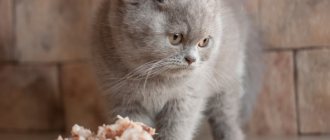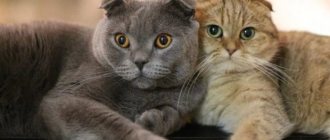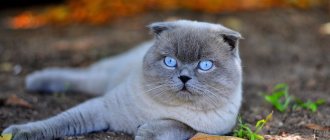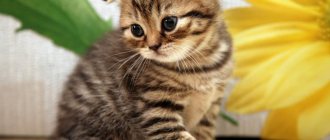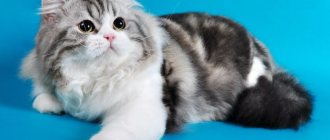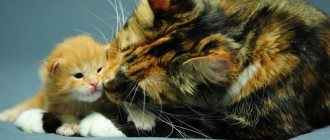These cats appeared relatively recently and were not recognized as a separate breed for a long time. The “British” were already proudly walking around the apartments, admiring their aristocratic appearance, and the “Scots”, who owed their birth to a spontaneous mutation, were not yet known to the general public.
Many consider only cats with floppy ears to be “Scottish”, while straight-eared cats are classified as a British breed. This is fundamentally wrong, since the British cat and the Scottish Straight are two completely different breeds.
History of the Scottish Straight breed
For a long time, only the fold-eared “Scots” were officially recognized. The first kitten with unusual ears appeared by chance in Scotland, and then they began to be bred, mating with the British breed, which was closest in parameters. In the litter that appeared after such crossings, both lop-eared and straight-eared cubs were born. Babies with straight ears resembled “British” in many respects, which is why until 2004 they were recorded as British Shorthairs.
In 2004, felinologists revised their opinion. Representatives of the Scottish breed, including Scottish Straights, differed from the “British” in character, and also had a less massive skeleton and had a different skull shape. These arguments were accepted, and straight-eared Scots were recognized as a separate breed, although not by all international organizations. However, under the patronage of WCF with the code SFS71, Scottish Straights can participate in exhibitions and receive champion titles.
Scottish Straights are not the only straight-eared representatives of the Scottish breed. Highland Straight is another variety of “Scots” with straight ears and long fur, unlike Scottish Straights.
Character
Scottish Straights are distinguished by their flexible character. They are very smart and not aggressive. Cats quickly become attached to the house and to their owners, having chosen one favorite. They do not like to be left alone and, if possible, are not averse to jumping into a person’s arms. At the same time, they will not impose their company if they see that the owner is not inclined to communicate.
New people in the house do not scare them, although sometimes cats want to be sad alone, then they climb into a quiet place. The voice of the Scottish Straight can not be heard often, they do not hysteria, do not meow loudly, except when begging for a treat.
The owner does not have to worry about the safety of the furniture and the cleanliness of the carpet: “Scottish dogs” are very clean and polite, they quickly get used to the tray and scratching post and indifferently walk past the soft sofa without putting their claws into it.
Straight-eared “Scots” easily get along with children and other animals, without showing any aggression or jealousy. They easily tolerate moving, changing home, familiar surroundings, and if due to circumstances they are forced to change owners, they quickly adapt to the new environment.
In a word, cats of this breed can be called ideal. The main thing is that there is food in the bowl and favorite toys on the rug.
Description of representatives
Many people confuse British Shorthairs and Scottish Straighthairs, but despite some similarities, there are a number of signs by which they can be distinguished.
Appearance
According to the WCF standard, the straight-eared “Scotsman” has the following appearance features:
- The body is of moderate length, muscular, but not massive. The shoulders and pelvis are the same width. The average weight of an adult is 3.5–5 kg. Males are usually larger than females.
- Limbs of medium length. The toes are pressed tightly against each other.
- The tail can be long or medium. It should be flexible and free of creases.
- The head is round in shape with a convex skull. The muzzle is round, the cheeks are voluminous. The nose is short, slightly arched at the transition to the forehead. The chin is round and strong. The mustache is luxurious, located on convex pads. The neck is short, not as powerful as that of the “British”. The eyes are large, wide open, and may be blue or amber. The ears are medium-sized with slightly pointed tips, set wide apart.
- The fur is medium length, dense. The range of colors is quite diverse - solid, bicolor, point, tortoiseshell, smoky, shaded, tabby.
The ideal Scottish Straight: rounded muzzle, widely spaced ears with slightly pointed tips, large, expressive eyes, voluminous cheeks, plush fur.
Photo gallery: Scottish Straight cat colors
White Scottish Straight looks luxurious
Black Scottish Straight - an elegant and mysterious animal
The blue coat of the Straights has a sheen that resembles the real shine of metal.
The eyes of Scottish Straights are creamy and amber in color.
Scottish Straight lilac color looks unusual and elegant
Red Scottish Straight looks very bright
The Scottish Straight bicolor color combines white and some other shade.
Tabby color (with stripes) is one of the most popular
The coat of the Scottish Straight point color has a basic light tone, and the muzzle, ears, paws and tail are dark.
The fur of tortoiseshell cats should be a combination of cream and dark shades.
The coat of Scottish Straight cats of smoky color should be uniform and have a silver-white base.
Shaded - a color in which only the upper third of the tip of the hair is colored, the rest is white
With a chinchilla color, one eighth of the hair length is colored, the rest is white
Gorgeous chocolate color is considered quite rare
Character
Distinctive character traits of the “Scots” are non-conflict and sociability. They adapt well to a new environment and find a common language with all family members, as well as other pets. Representatives of the breed are easy to train, well-mannered and quite playful.
Being attached to the owner, they do not require increased attention, and also cannot tolerate excessive displays of affection. Scottish Straights prefer to be close to a person, but do not like to be forcibly picked up. At the same time, the pet gets very bored when its owners are absent for a long time. In general, these cats are flexible, good-natured and unforgiving. It is these qualities that allow them to be considered one of the best pets.
Purchasing a kitten
It is best to purchase any purebred pet, including a Scottish Straight kitten, from a nursery with a good reputation. Every self-respecting breeder has his own website, where you can first familiarize yourself with the necessary information and look at photographs.
A good breeder will definitely allow you to visit the nursery so that the buyer can get acquainted not only with the pre-selected baby, but also evaluate the conditions of his keeping.
Criteria for choosing a kitten
What should a healthy purebred kitten look like? Here are the main criteria to consider when purchasing:
- the fur should not be dull, matted or bald;
- discharge from the eyes should not be excessive or colored;
- the ears should be clean, without pus or other suspicious discharge;
- the cub’s tummy should not be swollen, the anus should be clean and not protruding;
- there should be no underbite or overshot;
- the cub should not have difficulty walking, it should be playful and active, and easy to make contact with.
Breed characteristics of the “Scottish” that you should pay attention to when purchasing include:
- the shape of the muzzle is round;
- the shape and size of the ears - they should be small and in line with the cheekbones;
- the shape of the body - it should be slightly stretched, rectangular, tightly knit;
- condition of the tail - it should not have any kinks or knots;
- The fur should be plush and short.
A good breeder does not sell babies if they are not yet 2.5 months old. A kitten younger than this age is not yet ready to be separated from its mother and has not acquired the skills of independent living. The baby you like can be reserved - the breeder will give it to the owner when he is ready to move. The purchase of an animal must be documented in a sales contract. The breeder must also provide the buyer with a veterinary passport and pedigree of the pet.
Little straight-eared Scots resemble funny teddy bears, they seem to be smiling all the time
Vitamins and minerals
With a natural diet, the Scottish Straight kitten receives the necessary nutrients from foods. But at the same time, to fully balance the diet, pets are given additional vitamins and minerals.
Until 6-7 months, active development occurs, the skeleton is formed and strengthened, and milk teeth change. Due to high energy costs, the body needs fortified nutrition. During the period of active growth and development, Scots should receive vitamins A, E, D, C, K, group B. Microelements include iodine, selenium, calcium, sodium, magnesium, phosphorus.
Important! Use ready-made multivitamin-mineral complexes (Trivit, Tetravit, Gamavit). Before choosing a drug, consult your veterinarian.
Scots can also be given:
- fish oil (a drop every 6-7 days);
- dry yeast (1 g per serving every other day);
- meat and bone meal;
- calcium gluconate;
- crushed eggshells.
Note that deficiency, as well as excess of vitamins and minerals, harms the health of animals.
Features of care
Scottish Straights can be called one of the most unpretentious breeds to care for . A little attention and care, adherence to the principles of proper nutrition - and the pet will look great, be in excellent health, and will respond to the owner with adoration and devotion.
Behind the fur
It is enough to comb the coat of the Scottish Straight once a week, using alternately a sparse comb and a frequent brush made of natural bristles. At the end of the procedure, the remaining hairs should be collected with a wet palm. During the molting period, which happens approximately once every six months, combing will have to be done more often.
A new invention, the so-called paw (a fabric-based glove with a rubber stripe), allows you to comb out fur as efficiently as possible. The principle of operation of this device is based on a physical law - hairs tend to “stick” to silicone and rubber surfaces.
A special rubber glove is perfect for removing excess hair from Scottish Straights.
Scottish Straights are neat and clean animals, so frequent bathing is not necessary. In addition, the “Scots” are not enthusiastic about water procedures. For mild contamination, it is better to use dry shampoo, sold in pet stores, or bran heated in the oven. Both products should be applied to the coat and then combed out. If water procedures are still necessary, they should be carried out using special shampoos for short-haired cats.
It is more convenient to bathe a pet together; there is no need to soap its face, and the fur should be rinsed as thoroughly as possible.
Behind the eyes
Particular attention should be paid to the eyes of Scottish Straights. The fact is that this breed is characterized by a special structure of the muzzle, in which the animals are prone to frequent lacrimation. To remove moisture, use a soft cloth or dry cloth - cotton wool is not suitable due to the risk of lint getting into the eyes. You should not use water or wet wipes for pet hygiene - they disrupt the microflora and contribute to the development of the inflammatory process.
Behind the ears
Scottish Straight dogs need to have their ears inspected regularly. It is enough to clean them once a week using cotton swabs or discs that are not stitched along the edges. You can buy special products at the pet store that should be dropped into the ears before starting the procedure - they will soften plaque and dirt and make cleaning easier. Do not penetrate the stick deep into the ear canal to avoid injury. You need to clean carefully - from the base to the edge.
Behind the teeth
To maintain dental health, you can use dry food or special chewing toys sold in pet stores. There you can also purchase special paste and brush, which should be used to clean your teeth once every 7 days. If your cat's diet consists of natural products, it is useful to give her meat cut into large pieces to cleanse the mouth and train the jaw.
Behind the claws
To prevent damage to furniture and carpets, your pet must be trained to use a scratching post from an early age. But sometimes even with active use of it, the cat’s claws still remain quite long. Their circumcision using a special device - a nail cutter - should be carried out for babies under six months of age once every 14 days, and for adults - once every 30 days. The procedure must be carried out carefully - only the transparent part of the claw should be trimmed, without affecting the pink area where the blood vessels are located.
You should trim your pet's claws using a special device - a nail clipper.
Nutrition
Owners of Scottish Straights can choose for their pets a diet consisting exclusively of natural food products, or feed them premium ready-made food. When feeding naturally, you should know which products must be present in the “Scots” diet, and which are contraindicated for the animal. Permitted products include:
- Meat. Should be lean, boneless and make up 80% of the total diet. Beef, rabbit and poultry are suitable.
- Offal. It is enough to give no more than 1-2 times a week and only boiled.
- Dairy products. Should be low fat.
- Plant products. Can be boiled or served raw. Usually vegetables are mixed with meat - this makes the pet more willing to eat them.
- Fish. It is allowed to include only sea and low-fat seafood in the diet and no more than once a week.
- Porridge. Buckwheat, oatmeal and rice should be well boiled.
- Yolk. It is necessary to boil and give no more than 2 times a week.
All foods included in your pet's diet should not contain salt or spices. Any smoked, fried, pickled foods, as well as canned food, are prohibited. You should not give your pet small bones - he may swallow them and get hurt. Potatoes, bread, mushrooms and legumes are difficult to digest and are harmful to the animal's digestive system.
Cow's milk is also prohibited - after three months of age, cats develop lactose intolerance. They can use it with pleasure, but their well-being afterwards will be unimportant.
Your pet should always have two bowls - one for food, the other for water, which should always be fresh.
At the age of up to six months, the pet is fed up to 4 times a day; after six months, you can switch to three meals a day. When the Scottish Straight turns one year old, he becomes an adult cat. It is enough to feed an adult animal twice a day.
Pet stores sell special mixtures consisting of wheat, oats and other cereals. The grass grown from them should be freely available to the animal - it is not only a source of useful substances, but also removes lumps of fur from the stomach, which get there after the pet licks its fur.
The grass is rich in useful elements and also cleanses the pet’s stomach of hairballs
What feeding is contraindicated
It’s worth starting with how a straight-eared baby should under no circumstances eat:
- Excessively, by the way, is the most common mistake made by owners of small Scots. For some reason, it seems that a growing body needs as much food as possible. Meanwhile, the kitten often simply does not know the limits, eating much more than the norm if it is not controlled. By the way, an adult cat is sometimes also prone to overeating and his diet should be under control.
- Smoked, salted, fried, spicy foods are not only undesirable, but strictly prohibited. Any such food from the table, which seems very tasty to a person, can harm the kitten. And given that the development of small Scottish cats begins in the womb, it is also extremely important to protect a pregnant cat from such food. And in principle, even an adult feline will not benefit from such food.
- Bones - no way! They can hurt.
- Expired food is undesirable even for an adult cat, and will even harm the delicate stomach of the younger generation. Even food that has recently begun to spoil should be discarded.
- Unprocessed meat – it should be completely excluded from the diet. If an adult cat eats a raw piece of meat with pleasure and without negative consequences, the kitten will get indigestion.
- Fatty meat, just like raw meat, is accepted by the cat’s stomach without gratitude.
- Cream, sour cream are possible, but undesirable. The fact is that the listed products, according to some experts, are too heavy for the cat’s liver.
Scottish Straights are prone to diseases
Unlike the fold-eared variety of the Scottish breed, which is prone to joint problems, Scottish Straights have better health. They have a predisposition to certain diseases, but this does not mean that these pathologies will necessarily manifest themselves. The owner just needs to know about possible health problems in Scottish Straight dogs in order to recognize their signs in time and be able to provide first aid.
Diseases that may occur in Scottish Straights include:
- Urolithiasis disease. Males are more susceptible to this pathology than kittens. It manifests itself in frequent and painful urination - the animal may meow while sitting in the tray. Blood may also appear in the urine. A pet with this problem may often lick its genitals. If an illness is detected, you should visit a veterinarian as soon as possible. To alleviate your pet's condition, you can place a warm heating pad on his stomach - the heat will relieve spasms and reduce pain.
- Cardiomyopathy. This is a cardiac pathology, manifested by shortness of breath, difficulty breathing, and tachycardia. To prevent its development and alleviate the animal’s condition, in addition to appropriate therapy prescribed by a specialist, the owner must protect his pet from stress and take care to enrich his food with a sufficient amount of taurine.
Hypertrophic cardiomyopathy involves thickening of the walls of the heart ventricle, making it difficult to function
- Ear problems. The most common ear pathologies include otodecosis, or ear mites, and otitis media, an inflammatory process that can be caused by water, a cold, or the presence of parasites. If your pet scratches its ears, presses them up and shakes its head, or there is discharge from them, then you should contact a specialist.
- Discharge from the eyes. Clear, moderate discharge from the eyes is not a reason to panic. Their cause is the special structure of the “Scots” skull, in which the nasolacrimal ducts are greatly narrowed. You need to be concerned if the discharge becomes excessive, is colored in any color, your pet's eyelids are swollen and the eyes are difficult to open.
- Obesity. The tendency for Scottish Straights to gain excess weight is a genetic problem. The owner’s task is to adhere to the principles of proper nutrition and feed the pet with high-quality and healthy products.
- Worms. Symptoms of a worm infestation may include constipation or diarrhea, bloating, anal problems, eye discharge, changes in appetite, lethargy and bad breath. This pathology can also be asymptomatic. Deworming is carried out once every 3-4 months - for prevention, two weeks before the next vaccination, before castration and before mating. Experts recommend the drugs Pirantel, Drontal, Kanikvantel.
Kanikvantel is a drug for the prevention and treatment of helminthic infestations, recommended by veterinarians
- Ringworm. Symptoms of the pathology, which is also dangerous for humans, are spots on the skin, itching and hair loss. Treatment for lichen can take up to 1.5 months. During this period, it is necessary to limit the animal’s contact with all family members and carry out a general cleaning of the house. For treatment, Miconazole, Clotrimazole ointments, Nizoral shampoo, Vakderm or Microderm vaccines are used.
Ringworm in a cat leads to the appearance of patches of baldness on the fur.
Defects that do not allow participation in exhibitions
Defects in appearance for which a Scottish Straight cannot be allowed to participate in the competition include:
- arched back;
- twisted hind limbs;
- hard, immobile or too short tail;
- hook on the tail;
- wide and large ears;
- flat forehead;
- massive bones;
- wrong number of fingers;
- fused fingers.
How to choose the right food for a 2 month old Scottish Fold kitten
Breeders advise feeding your pet the same food that its mother consumed. But if the new owners do not have the opportunity to buy expensive food, then the feed manufacturer and the type of product are selected individually. Carefully, giving a small amount of food, monitor the Scotsman’s condition. In the absence of negative effects, the feed is introduced for continuous use. It is especially necessary to ensure the compliance of all microelements and vitamins in it. When eating natural products, the daily diet is varied. The pet should receive lean meat, fresh sea fish, vegetables, cereals, and dairy products. You should not feed your Scotsman potatoes, legumes, onions, pork or lamb.
Mating Scottish Straights
Following certain rules when mating Scottish Straights will help you get beautiful and healthy offspring. To the question of who can be the partner of a straight-eared “Scotsman” or a cat, there is only one answer. Scottish Straights are mated exclusively with their fold-eared relatives - Scottish Folds or Highland Folds. The ideal compatibility of genes and breed characteristics allows you to obtain offspring characterized by excellent health and charming appearance. A litter may contain babies with both straight and curled ears.
Scottish Straights are bred only with their fold-eared relatives so that the offspring are healthy
At what age is an animal ready for mating?
Scottish cats reach sexual maturity at 9–10 months. But you can’t knit them at this age. Early bearing of offspring can lead to serious pathologies, and the cubs may die during childbirth or be born with serious abnormalities. The female is ready for mating at the age of one and a half years. It is during this period that you need to look for a suitable partner for the cat and do this in advance, because the cat’s heat lasts no more than 4-6 days.
Cats are considered sexually mature at the age of 10 months. From this age, they can participate in matings at any time. The male demonstrates especially increased sexual activity in the spring. He begins to show anxiety, sometimes behaves aggressively and marks his territory.
Choosing a partner and mating rules
Mating always takes place on the cat's territory. The cat is taken to the “groom” and provided with everything necessary - familiar food, its own litter box, the smell of which is familiar to it, so that it feels comfortable. Before mating, the animals must get to know each other - you need to give them a little time. Pets cannot be forced to mate if one of them is not ready for it.
The male must be larger than the female, the same or similar color. Before mating, both partners must undergo deworming and be vaccinated. The cat usually spends two days with the cat - during this time several matings occur.
Special ready-made food: what to prefer
The most important rule in this case is that the food must be “premium class”. Even if such food is more expensive, it will definitely not cause harm and will be beneficial. As for the consistency, breeders especially like to feed their little charges mousse - it is most convenient to eat.
Food for babies must be designed for their age, since pellets for adult animals are larger and, as a result, inconvenient. As for brands, you should pay attention to the following:
- “Hills” - contains phosphorus, magnesium, calcium in excellent balance. It has a medicinal line of foods available, but you should first consult with a veterinarian about the advisability of using them.
- "Royal Canin" - contains enough fiber and an acceptable dosage of quickly digestible proteins. Helps create an optimal balance of intestinal flora and normalize the animal's stool.
- “Innova EVO” is favored by experienced breeders due to its composition of fresh meat and vegetables, oils, minerals, and vitamins. Fats and oils have a good effect on the immunity of kittens, and the absence of harmful impurities and even taste and smell enhancers guarantees high quality food.
- “Matisse” - most of the composition is chicken meat and fat, rice, fish, eggs. In addition, the food contains a whole complex of vitamins and calcium.
Scottish is a breed that attracts with its beauty and dignity. However, for all this, just a good pedigree is not enough - care is also of no small importance. But there is nothing complicated about the issue of proper feeding if you figure it out in advance and don’t improvise on the fly.
Previous
Scottish Straight (Scottish Straight)We buy Scottish Straight - selection and prices
Next
Scottish Straight (Scottish Straight) Scottish Straight health - diseases, prevention, vaccinations and basic information
Castration and sterilization
There comes a time in the life of every pet owner when a cute and fluffy animal, entering puberty, turns into a restless, meowing and apartment-marking creature. If the owner of a Scottish Straight does not plan to engage in breeding and wants to save himself from unpleasant moments associated with the animal’s sexual life, he decides to sterilize or castrate the pet. Both of these operations, differing in the mechanism of their implementation, deprive the pet of the desire and ability to reproduce.
Sterilization is a term that combines several surgical techniques. Almost all of them, while depriving the animal of the opportunity to reproduce, do not relieve it of the need to mate. Castration is the complete removal of the genital organs of both male and female cats. Pets subjected to the castration procedure not only lose their reproductive function, but also lose interest in the opposite sex.
Many people choose the castration procedure - it is easier to carry out and costs less. After it, the animal becomes calm and affectionate. In addition, castration reduces the risk of developing some serious pathologies. Surgery should be performed on Scottish Straight cats at 10–12 months of age. It is absolutely safe and does not take much time. The pet can be taken home on the same day, where it will quickly recover from anesthesia and soon return to its normal life.
Post-operative care
After castration, it will be convenient to carry your pet home. Until the animal recovers from anesthesia, it is better to stay close to it. It is better to place it on the floor on a bedding - the cat may fall from the sofa or bed. When the animal comes to its senses, it may behave inappropriately - be afraid of sharp sounds and even familiar people and objects. Modern surgical techniques do not involve suturing. It is necessary to ensure that postoperative wounds are clean and treat them with brilliant green. They will heal after about 10–14 days.
When and how to bathe a 2 month old Scottish Fold kitten?
A small pet begins to be bathed only from the age of two months, and then only when it is heavily soiled or when fleas appear. Wash in warm water about 36 degrees with special shampoo. It is better to pour the water in advance, because the Scotsman is very frightened by its noise. It is advisable to put a rubber toy in the bath and water the animal from a ladle. The soap solution must be washed off thoroughly so that when licked, the product does not cause irritation.
Before bathing, oil drops are instilled into the pet's eyes to prevent irritation of the mucous membrane. Cotton swabs are inserted into the ears. After the water procedure, the baby’s fur is dried with a towel and a hairdryer at a distance of half a meter. Make sure your kitten doesn't catch a cold. The shampoo that the owners use is not suitable for the kitten; it will cause severe allergies.
